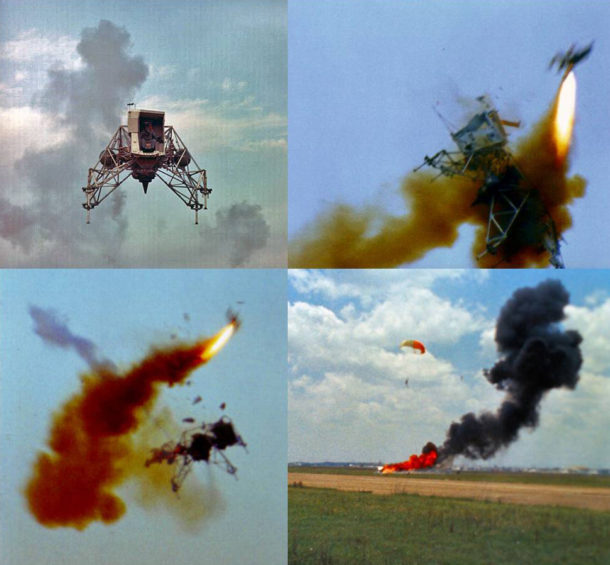
Fifty-one years ago this month, NASA Astronaut Neil A. Armstrong narrowly escaped with his life when he was forced to eject from the Lunar Landing Research Vehicle in which he was training. Armstrong punched-out only 200 feet above ground level and spent just 4 seconds in the silk before safely landing.
The Lunar Module (LM) was the vehicle used by Apollo astronauts to land on and depart from the lunar surface. This unique spacecraft consisted of separate descent and ascent rocket-powered stages. The powered descent phase was initiated at 50,000 feet AGL and continued all the way to landing. The powered ascent phase lasted from lunar lift-off to 60,000 feet AGL.
It was recognized early in the Apollo Program that landing a spacecraft on the lunar surface under vacuum conditions would be very challenging to say the least. To maximize their chances for doing so safely, Apollo astronauts would need piloting practice prior to a lunar landing mission. And they would need an earth-bound vehicle that flew like the LM to get that practice.
The Lunar Landing Research Vehicle (LLRV) was the answer to the above. The LLRV employed a turbojet engine that provided vertical thrust to cancel five-sixths of its weight since the gravity on the Moon is one-sixth that of Earth. The vehicle was also configured with dual lift rockets to provide vertical and horizontal motion. LLRV 3-axis attitude control was provided by a series of 16 small thrusters.
The LLRV was described by one historical NASA document as being “unconventional, contrary and ugly”. Known as the “Flying Bedstead”, the LLRV was designed for the specific purpose of simulating LM flight during the terminal phase of a lunar landing. The LLRV was not easy to fly in the “low and slow” flight regime in which it operated. The type was aesthetically unattractive in the extreme.
A pair of LLRV’s were constructed by Bell Aerosystems and flight tested at what is now the NASA Dryden Flight Research Center starting in October 1964. These vehicles were subsequently shipped to Ellington Air Force Base in Texas by early 1967. A number of flight crew, including Neil Armstrong, began LLRV flight training shortly thereafter.
Neil Armstrong made his first LLRV flight on Monday, 27 March 1967 in LLRV No. 1. (This occurred two months after the horrific Apollo 1 Fire.) Armstrong continued flight training in the LLRV over the next year in preparation for what would ultimately be the first manned lunar landing attempt in July of 1969
On Monday, 06 May 1968, Armstrong was flying LLRV No. 1 when the vehicle began losing altitude as its lift rockets lost thrust. Using turbojet power, Armstrong was able to get the LLRV to climb. As he did so, the vehicle made an uncommanded pitch-up and roll over. The attitude control system was unresponsive. The pilot had no choice but to eject.
Neil Armstrong ejected from the LLRV at 200 feet AGL as LLRV No. 1 crashed to destruction. The pilot was subjected to an acceleration of 14 G’s as his rocket-powered, vertically-seeking ejection seat functioned as designed. Armstrong got a full chute, but made only a few swings in same before safely touching-down back on terra firma. His only injury was to his tongue, which he accidently bit at the moment of ejection seat rocket motor ignition.
A mishap investigation board attributed the LLRV mishap to a design deficiency that allowed the helium gas pressurant of the lift rocket and attitude control system fuel tanks to be be accidently depleted. Thus, propellants could not be delivered to the lift rockets and attitude control system thrusters.
Neil Armstrong and indeed all of the Apollo astronauts who landed on the Moon trained in improved variants of the LLRV known as the Lunar Landing Training Vehicle (LLTV). This training was absolutely crucial to the success of the half-dozen Apollo crews who landed on the Moon. Indeed, there was no other way to adequately simulate moon landings except by flying the LLTV.

